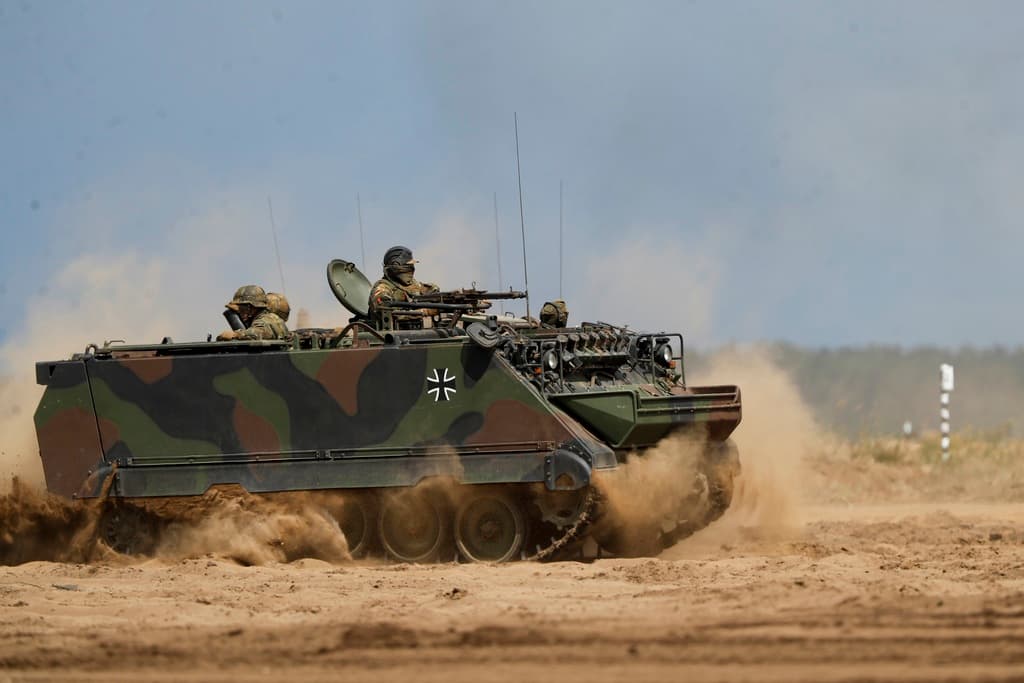Get Worried: Putin Is Expressing Concern for Russian Speakers in the Baltics
Twenty-nine years after the last Forest Brother emerged from the woods, Russia is signaling that it covets the Baltics again.

Echoing the political posturing he used before invading Ukraine, President Putin is showing an ominous concern for the plight of Russian speakers living in the three Baltic nations. Although the ethnic Russian population has dropped in half since Latvia, Lithuania, and Estonia won independence from the Soviet Union in 1991, Mr. Putin is signaling that, after Ukraine, the Baltics are next.
Last week, the Russian leader took aim at Latvia, which has a large Russian-speaking minority. “They treat them in such a pig-like manner, then they themselves will face the same pig-like behavior within their country,” Mr. Putin said last week of Latvia. In response, he said, Russia should develop “systemic measures.”
In 2010, Mr. Putin occupied Crimea and much of southeastern Ukraine alleging that he was protecting the rights of Russian-speakers. In 2022, he made similar arguments to launch a full-scale attack on Ukraine. Ironically, the areas most devastated by Russia’s artillery and land assaults are Ukraine’s border areas, overwhelmingly Russian-speaking.
President Zelensky of Ukraine, on a tour of the three Baltic nations last week, warned leaders to take Mr. Putin’s words seriously. Mr. Putin “won’t finish this, until we all finish him together,” Mr. Zelensky said. He added “Lithuania, Latvia, Estonia, Moldova may be next.”
Mr. Zelensky’s warnings are bolstered by threats to Russia’s neighbors made repeatedly by Kremlin insiders. “They understand very well that Ukraine is finished. So, what’s next?” a member of the Russian Duma, Aleksey Zhuravlov, asked last week on Russian state-run TV. “The Poles have quieted down a bit, they probably started to realize that they are next.” From the late 1700s until 1918, most of Poland, Latvia, Lithuania and Estonia were parts of the Russian Empire.
Short term, Russia is too tied down in Ukraine to pose an immediate threat to Poland and the Baltics, according to President Ursula von der Leyen of the European Commission. “Russia has lost roughly half of its military capabilities,” she said last week, noting as well that Russia has lost half of the Ukrainian land that it initially conquered in 2022 and has been pushed out of the western Black Sea.
American and European military planners, though, are preparing for the medium and long term. Poland and the three Baltics are NATO members, bound by the charter’s all-for-one, one-for-all mutual defense clause. On Thursday, NATO’s top commander, General Christopher Cavoli, told reporters in Brussels that NATO is launching its largest exercise since the Cold War.
Through May, 90,000 soldiers and sailors are to participate in Steadfast Defender 2024, an exercise that will focus on defending Poland and the Baltics. This is NATO’s largest exercise in Europe since Reforger, which mustered 125,000 troops in 1988 — three years before the collapse of the Soviet Union. Without citing Russia by name, General Cavoli, a United States Army general, said the exercise will focus on responding to “conflict scenarios with a near-peer adversary.”
In another step, the defense ministers of Germany and Lithuania signed last month an agreement for Germany to permanently station a brigade of 4,800 soldiers in Lithuania.
This brigade will be Germany’s first foreign deployment of troops since World War II. Germany’s defense minister, Boris Pistorius, told reporters at Vilnius, Lithuania’s capital: “The eastern flank has now moved to the east — and it’s the duty of Germany to protect it.” Germany already leads NATO’s multinational battle group of 1,000 soldiers in Lithuania.
From the Lithuanian side, Defense Minister Arvydas Anusauskas said: “We should expect not only good scenarios, but also the very worst scenarios. So we must be ready … Russia remains the main threat to us and NATO.”
Further shoring up NATO’s eastern flank, America signed a defense cooperation agreement last month with Finland, which has an 830-mile long land border with Russia. Last year, Finland abandoned eight decades of neutrality and joined NATO. Under the new agreement with Washington, America’s military will enjoy unimpeded access to 15 bases and facilities in Finland.
Last month, Sweden signed a similar agreement with America. This year, Sweden expects to join NATO. Sweden has been neutral since 1812. France is pivoting to Europe from Africa, training Estonian soldiers. On Sunday, Bild reported that a classified document, “Alliance Defense 2025,” shows how Germany’s armed forces, the Bundeswehr, are preparing to counter a westward offensive by Russia’s Army.
To prepare the ground for the attack, Russia could start this summer to conduct hybrid warfare in the Baltics, where they would incite ethnic Russian minorities. The spokeswoman of Russia’s foreign ministry, Maria Zakharova, replied on her Telegram channel: “I read the German ‘secret plan’ leaked into the Bild information gutter. It’s like a mighty horoscope from last year for Pisces in Cancer.”
At issue for the Kremlin is the plight of Russian-speakers in the Baltics. This strikes an emotional chord for Russians. They saw millions of ethnic Russians return to the Russian Federation after the 1991 collapse of the Soviet Union, which was a forced union of 15 republics. In the Baltics, the “Russian world” has shrunk to about 900,000 people, largely through emigration and death. The population of the three countries adds up to 6.5 million people.
In Latvia, the parliament passed laws last fall phasing out Russian language study in government schools, requiring all resident Russian citizens to swear loyalty to Latvia and to attain advanced beginner command of Latvian. None of the three Baltic languages are part of the Slavic language family. Estonian is Finnic. Latvian and Lithuanian are Baltic. Almost one quarter of Latvia’s population of 1.8 million belong to the ethnic Russian minority. Most have Latvian citizenship.
Setting off alarm bells in Russia’s state-controlled press, Latvia’s Office of Citizenship and Migration Affairs recently said it would deport about 1,200 Russian citizens who failed to apply for new residence permits by a December 31 deadline. Mr. Putin charged that Latvia plans to dump them on the border “in wheelchairs.” Reading the tea leaves, the Washington-based Institute for the Study of War warned Tuesday: “Putin may be setting information conditions for future aggressive Russian actions abroad under the pretext of protecting its ‘compatriots.’”
Atlantic Council Ukraine Alert’s editor, Peter Dickinson, similarly warned Tuesday: “If Putin chooses to apply his weaponized version of Russian imperial history in its broadest sense, the list of potential targets would include Finland, Poland, Belarus, the Baltic states, Moldova, Azerbaijan, Georgia, Armenia, Alaska, and the whole of Central Asia.”
Despite their small sizes, the three Baltic nations — like Ukraine — have a history of tenacious national warfare against control from Moscow. From 1944 to 1956, about 50,000 Latvians, Lithuanians, and Estonians participated in partisan resistance against Russian rule, fighting in a movement known as the “Forest Brothers.”
Moscow was able to suppress the guerrillas only through repression, executing thousands of fighters and deporting half a million people to Siberia. The last Forest Brother was Jānis Pīnups, a Latvian. He came in from the woods in 1995, six months after the last Russian soldiers left Latvia.

